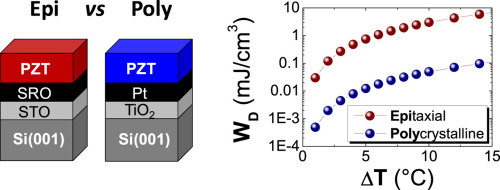当前位置:
X-MOL 学术
›
Nano Energy
›
论文详情
Our official English website, www.x-mol.net, welcomes your
feedback! (Note: you will need to create a separate account there.)
Huge gain in pyroelectric energy conversion through epitaxy for integrated self-powered nanodevices
Nano Energy ( IF 16.8 ) Pub Date : 2017-09-05 , DOI: 10.1016/j.nanoen.2017.09.001 Rahma Moalla , Bertrand Vilquin , Guillaume Saint-Girons , Gwenael Le Rhun , Emmanuel Defay , Gael Sebald , Nicolas Baboux , Romain Bachelet
Nano Energy ( IF 16.8 ) Pub Date : 2017-09-05 , DOI: 10.1016/j.nanoen.2017.09.001 Rahma Moalla , Bertrand Vilquin , Guillaume Saint-Girons , Gwenael Le Rhun , Emmanuel Defay , Gael Sebald , Nicolas Baboux , Romain Bachelet

|
Polycrystalline (textured) and epitaxial 500 nm thick Pb(Zr0.52Ti0.48)O3 (PZT) layers have been monolithically integrated in metal-insulator-metal structure on silicon in order to compare their pyroelectric properties, both statically (under stabilized temperatures) and dynamically (when submitted to temperature transient as a pyroelectric device should work). The films have roughly the same out-of-plane orientation, and thus a similar out-of-plane remnant ferroelectric polarization around 12 μC/cm2. Whereas their static pyroelectric coefficients are similar (around −470 μC m−2 K−1), the dynamic pyroelectric coefficient of the epitaxial layer is about one order of magnitude larger than that of the polycrystalline layer (−230 vs −30 μC m−2 K−1). This causes an important difference on the densities of converted pyroelectric energy by almost two orders of magnitude (1 vs 1.5 10−2 mJ/cm3 per cycle for temperature variations of ∼6 K). This difference is explained here by the counterbalanced extrinsic pyroelectric contribution arising from the domain walls motion in the dynamical measurements. Extrinsic pyroelectric contribution appears almost twice larger on polycrystalline layer than on epitaxial layer (+430 vs +250 μC m−2 K−1). These results are crucial for further design of advanced integrated pyroelectric-based nanodevices.
中文翻译:

通过外延获得集成自供电纳米器件的热电能量转换的巨大收益
多晶(结构化)和外延500 nm厚的Pb(Zr 0.52 Ti 0.48)O 3(PZT)层已单片集成在硅上的金属-绝缘体-金属结构中,以便比较它们的热电性能(静态(在稳定温度下))和动态(当作为热电设备提交到温度过渡应该工作)。薄膜具有大致相同的面外取向,因此具有约12μC/ cm 2的相似的面外残余铁电极化。它们的静态热电系数相似(大约-470μCm -2 K -1),外延层的动态热释电系数比多晶层的动态热释电系数大大约一个数量级(-230对-30μCm -2 K -1)。这在转换后的热电能量密度上引起了大约两个数量级的重要差异(温度变化约为6 K时,每个周期1对1.5 10 -2 mJ / cm 3)。在此,通过动态测量中畴壁运动产生的平衡的外部热释电贡献来解释这种差异。外源热电贡献在多晶层上的表现几乎是在外延层上的两倍(+430 vs +250μCm -2)K -1)。这些结果对于进一步设计先进的集成热释电纳米器件至关重要。
更新日期:2017-09-06
中文翻译:

通过外延获得集成自供电纳米器件的热电能量转换的巨大收益
多晶(结构化)和外延500 nm厚的Pb(Zr 0.52 Ti 0.48)O 3(PZT)层已单片集成在硅上的金属-绝缘体-金属结构中,以便比较它们的热电性能(静态(在稳定温度下))和动态(当作为热电设备提交到温度过渡应该工作)。薄膜具有大致相同的面外取向,因此具有约12μC/ cm 2的相似的面外残余铁电极化。它们的静态热电系数相似(大约-470μCm -2 K -1),外延层的动态热释电系数比多晶层的动态热释电系数大大约一个数量级(-230对-30μCm -2 K -1)。这在转换后的热电能量密度上引起了大约两个数量级的重要差异(温度变化约为6 K时,每个周期1对1.5 10 -2 mJ / cm 3)。在此,通过动态测量中畴壁运动产生的平衡的外部热释电贡献来解释这种差异。外源热电贡献在多晶层上的表现几乎是在外延层上的两倍(+430 vs +250μCm -2)K -1)。这些结果对于进一步设计先进的集成热释电纳米器件至关重要。











































 京公网安备 11010802027423号
京公网安备 11010802027423号